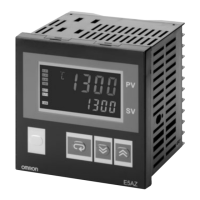43
Determining PID Constants (AT, ST, Manual Setup) Section 3-8
3-8 Determining PID Constants (AT, ST, Manual Setup)
3-8-1 AT (Auto-tuning)
• When AT is executed, the optimum PID constants for the set point at that
time are set automatically. A method (called the limit cycle method) for
forcibly changing the manipulated variable and finding the characteristics
of the control object is employed.
• To execute AT, specify on (AT execute), and to cancel AT, specify off
(AT cancel).
• AT cannot be executed when control has stopped or during ON/OFF con-
trol.
• The results of AT are reflected in the “proportional band” (P), “integral
time” (I), and “derivative time” (D) parameters in the adjustment level.
AT Operations AT is started when the “AT execute/cancel” parameter is set to ON. During
execution, the “AT execute/cancel” parameter on the No. 1 display flashes.
When AT ends, the “AT execute/cancel” parameter turns OFF, and the No. 1
display stops flashing.
If you move to the operation level during AT execution, the No. 2 display
flashes to indicate that AT is being executed.
Only the “communications writing,” “RUN/STOP,” and “AT execution/cancel”
parameters can be changed during AT execution. Other parameters cannot
be changed.
at
i
233
C
p
(0
d
40
Adjustment Level
Proportional band
Integral time
Derivative time
at
off
at
on
AT execute/cancel
No. 1 displa
AT execution in progress
C
25
100
C
25
100
PV/SP
AT execution in progress
No. 2 display

